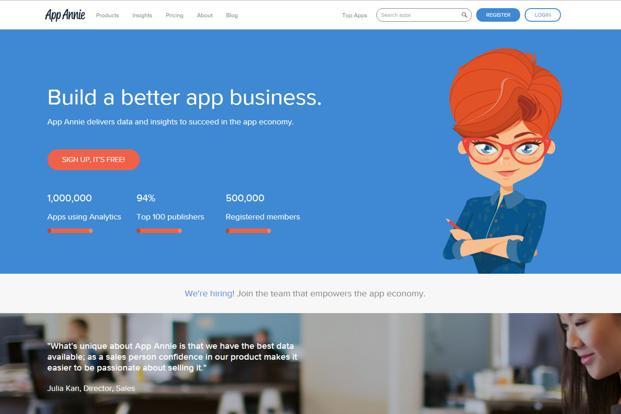 App Annie—derived from App Nanny, to imply it takes care of all things app—is mostly unknown outside of tech circles yet counts the biggest names in the industry among its customers.
App Annie—derived from App Nanny, to imply it takes care of all things app—is mostly unknown outside of tech circles yet counts the biggest names in the industry among its customers.
Singapore: A Singaporean shophouse may seem an unlikely symbol of Asia’s mobile boom. Yet one muggy evening in March, about a hundred people packed App Annie Ltd’s new and larger offices to mark its plan to capture data on millions of new smartphone users.
The start-up will triple staffing at its office in Singapore to 25 people this year as it targets new customers in India and Southeast Asia for the data it compiles on apps, how often they are used and the revenue generated. That’s being bankrolled by a recent $63 million funding, which also helped pay for the soiree attended by executives from the industry’s biggest names: Google Inc., Sequoia Capital and Zalora among them.
App Annie is going where the demand is. Spending on mobile apps in Asia is expected to surge 24% to $28.3 billion this year—double that of the Americas—as rising incomes spur smartphone use in markets such as Indonesia. With more than 150 workers in China, where the company got its start before relocating to San Francisco, the Singapore expansion will help it measure the users around the region who’re bypassing earlier technologies.
“Devices are getting cheaper and many consumers are experiencing their first Internet experience through an app in smartphone,” said Bertrand Schmitt, the company’s bespectacled 39-year-old founder. “Asia Pacific is already big and it keeps getting bigger. For us, that makes the region very exciting as a market. Revenue and downloads, growth are expected to be big.”
App Annie expects China to overtake the US this year to become the largest single app market with an estimated $11.8 billion in revenue. China is already the world’s biggest smartphone market while India has passed the US for second place.
The surging number of mobile devices and people going online through apps for the first time are fueling Asia’s mobile software arena, said Avinash Sundaram, a research manager for enterprise mobility at IDC in Singapore.
“Asia is a clean slate and there are no legacy systems people have to worry about,” he said. “So they have the freedom to create new business models, which is helping to drive this app economy in Asia.” He cited Tencent Holdings Ltd’s payments- to-voice messaging service WeChat as an example.
App Annie—derived from App Nanny, to imply it takes care of all things app—is mostly unknown outside of tech circles yet counts the biggest names in the industry among its customers. It competes with Yahoo Inc.’s Flurry and Apptopia, making money by collating data from different sources and then signing up clients for subscriptions of $10,000 to more than $1 million a year.
Game developers to sharing-economy players rely on its data and analytics to keep track of their businesses as well as their competitors’. Google uses App Annie’s services, as does Chinese search rival Baidu Inc. while other customers include Samsung Electronics Co., LinkedIn Corp. and Amazon.com. Inc.
In favour
About one-fifth of App Annie’s customers are venture capital firms including Redpoint Ventures, according to Schmitt. They use the data to inform their investment decisions and avoid pitfalls as the global economy cools. Its own backers include Sequoia and Institutional Venture Partners.
Market trends appear in their favour. Consumer spending on mobile apps in the Asia Pacific region, home to more than half the global population, is expected to reach $57.5 billion by 2020, App Annie estimated in February. That’s more than half of the estimated worldwide consumer spending on apps of $101.1 billion.
In markets like India, the influx of smartphones priced below $50 is boosting adoption and downloads. In November 2015, average data usage per smartphone user in India and Indonesia grew by more than 50% on year, according to App Annie.
Longer term, the shift to a mobile-oriented economy is inevitable, he said.
“Every business is becoming an app business,” Schmitt said. “Because people are spending so much time on the phone, you need an app to provide a constant, connected experience for your consumers.”
[“source-Livemint”]




